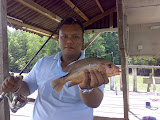Soft Plastic Lure
Any lure made of a soft, rubbery material is classified in the soft plastic range these days. The life like action of soft plastics, combined with versatility in rigging and price, makes them extremely popular. Soft plastics do actually work, especially if the user takes the time to understand the rigging, presentation and tactics in use.As simple as this rig looks, it's critical to get it exactly right. Scrunched, bent or twisted tails don't swim properly, often spin in the water, causing line twist, and will deter fish from biting.
This is the most basic of all rigs for soft plastics, and also arguably the best.
Begin by laying the jig/hook alongside the soft plastic, with the nose of the soft plastic held level with the back of the jig head. Note exactly where the bight of the jigs hook comes to on the back (top) of the soft plastics tail. This will be the exit spot for the hook point to exit.
Push the point of the jig hook into the front of the soft plastic lure, in the centre of its head or nose. Thread the soft plastic lure onto and around the hook bend so that the point of the hook exits the back of the plastic exactly on the centre line and at that point you noted earlier. Snug the nose of the plastic up against the back of the jig head and glue if preferred.
If your lure looks neat on the hook and the point comes out dead on the centre line of the plastic's back, you probably have it right. If it looks in any way dodgy, slightly crooked, bent, skewed or bunched up, do it again!
Drop the lure in the water and check its action. Pulling it along for a metre checking its action is strongly advisable. If the plastic swims straight on the test run, the tail wobbles or kicks enticingly, and the lure looks like something that might actually be alive, then you've rigged it properly.
With all flick or stick bait style of soft lure, the rigging method is exactly the same, but you need to actually cast the lure a couple of metres and work it back with a few pauses and flicks from the rod tip checking it kicks and flashes and jinks and darts—looking like a wounded, dying bait fish.










0 comments:
Post a Comment